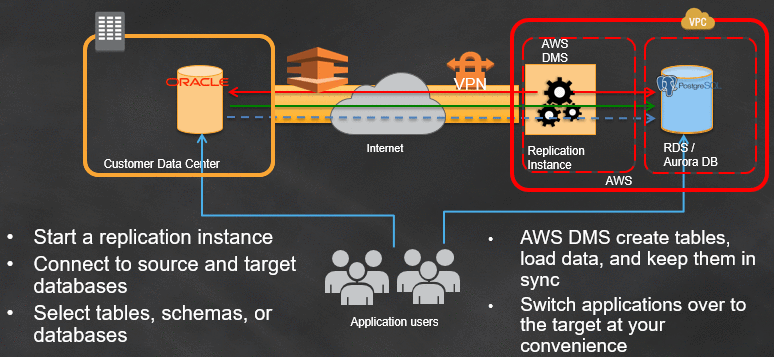AWS Database Blog
Category: Amazon RDS
Best practices for migrating an Oracle database to Amazon RDS PostgreSQL or Amazon Aurora PostgreSQL: Source database considerations for the Oracle and AWS DMS CDC environment
An Oracle to PostgreSQL migration in AWS Cloud can be a complex multistage process with different technologies and skills involved, starting from the assessment stage to the cutover stage. To better understand details of the complexities involved, see the AWS Database Blog post Database Migration—What Do You Need to Know Before You Start? This blog […]
Best practices for migrating an Oracle database to Amazon RDS PostgreSQL or Amazon Aurora PostgreSQL: Migration process and infrastructure considerations
An Oracle to PostgreSQL migration in the AWS Cloud can be a complex multistage process with different technologies and skills involved, starting from the assessment stage to the cutover stage. This blog series covers the environment and configuration setups for your source Oracle database, the AWS Database Migration (AWS DMS) service, and the target PostgreSQL […]
How to use CloudWatch metrics to decide between General Purpose or Provisioned IOPS for your RDS database
July 2023: This post was reviewed for accuracy. In this blog post, I talk about how you can use Amazon CloudWatch metrics to understand when you might benefit from provisioned IOPS, also known as IO1 volumes, for highest performance mission-critical database workloads. I start by setting up a test case that simulates a nonbursting consistent […]
Powering up Database Mail on Amazon RDS for SQL Server – How Under Armour runs Database Mail on Amazon RDS for SQL Server
Update [11/04/2020]: We’re happy to announce that Amazon RDS for SQL Server now fully supports SQL Server Database Mail. With the release of Database Mail for SQL Server, you can enable Database Mail seamlessly by using database parameter groups. Check this blog post for more information. Database Mail is one of the heavily […]
RDS SQL Server has two new exciting backup and restore enhancements
Amazon Relational Database Service (Amazon RDS) is the primary mechanism for running relational databases in the AWS Cloud. Amazon RDS for SQL Server supports running SQL Server versions from SQL Server 2008 R2 to SQL Server 2017. The RDS for SQL Server team has recently released two key improvements around backup and restore for native […]
Migrating Oracle Autonomous Transactions to PostgreSQL
July 2023: This post was reviewed for accuracy. Migrating and operating a database includes layers of complexity and thorough planning. Amazon RDS for PostgreSQL and Amazon Aurora with PostgreSQL compatibility can help you manage a variety of use cases. While migrating from Oracle to PostgreSQL, it’s very common to come across Oracle Autonomous Transactions. This […]
Supercharge your Amazon RDS for MySQL deployment with ProxySQL and Percona Monitoring and Management
So your organization is looking to deploy an application to the cloud, and you plan to use Amazon RDS for MySQL for the data tier… great! Let’s look at some of the best practices to ensure that you get the most out of your architecture.
Best practices for upgrading SQL Server 2008 R2 to SQL Server 2016 on Amazon RDS for SQL Server
In preparation for the deprecation of Microsoft SQL Server 2008 R2, this blog post focuses on how to upgrade from SQL Server 2008 R2 to SQL Server 2016 on Amazon RDS for SQL Server. In addition, you can apply many of the practices in this post to all versions of SQL Server or even other […]
Tuning Amazon RDS for MySQL with Performance Insights
Amazon RDS Performance Insights brings an intuitive tuning interface to Amazon RDS to help you discover and investigate performance issues on your RDS databases. The look and feel of Performance Insights is the same across all database engine types, such as RDS for MySQL, RDS for PostgreSQL, and Amazon Aurora. However, every engine has a […]
Set alarms on Performance Insights metrics using Amazon CloudWatch
Amazon RDS Performance Insights recently released a feature that sends key performance metrics from Performance Insights to Amazon CloudWatch. Using this feature, you can set alerts on these metrics. When Performance Insights is enabled, it automatically sends the following three metrics to CloudWatch: DBLoad DBLoadCPU DBLoadNonCPU I describe these three metrics following. DBLoad The first […]









